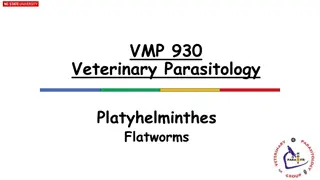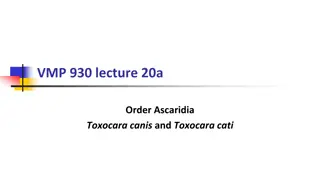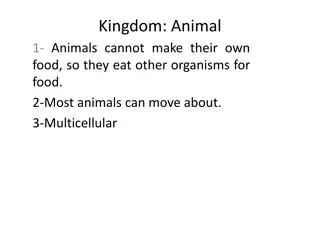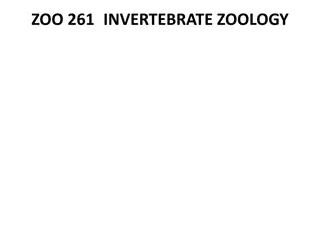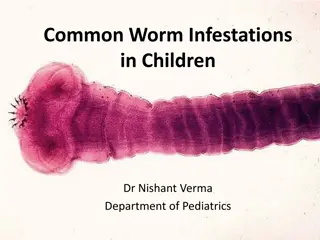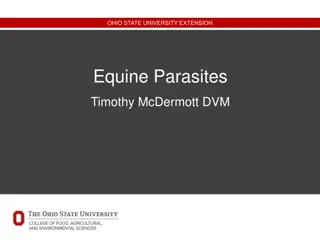Understanding Flatworms and Roundworms in Veterinary Parasitology
This comprehensive content explores the world of flatworms and roundworms in veterinary parasitology. It covers various classes such as Turbellaria, Monogenea, Trematoda, and Cestoda, detailing their characteristics, importance in veterinary medicine, and complex life cycles. The content touches on
1 views • 34 slides
Understanding Ascarids: Toxocara Canis and Toxocara Cati
Ascarids, also known as roundworms, are large parasitic worms that specifically infect different animal hosts. Toxocara canis affects dogs, while Toxocara cati affects cats. These worms have distinct characteristics and can cause health issues like pot-belly in young animals. Understanding their lif
0 views • 40 slides
Understanding Parasitism in Veterinary Medicine
Parasites can cause significant harm to animals by interfering with normal physiological processes. They can be ectoparasites (external) like mites and ticks, or endoparasites (internal) such as roundworms and hookworms. Diagnosis of parasitism is crucial for effective treatment, with common species
0 views • 27 slides
Overview of Animal Kingdom's Phyla and Characteristics
Animals in the Kingdom Animalia have diverse characteristics and are classified into different phyla based on specific traits and features. This includes Porifera (sponges), Cnidaria (jellyfishes), Platyhelminthes (flatworms), Nematoda (roundworms), Annelida (earthworms), Mollusca (snails, octopus),
0 views • 10 slides
Exploring the World of Invertebrate Zoology: Phylum Nematoda and Its Classes
In this detailed study of invertebrate zoology, we delve into the Phylum Nematoda, commonly known as roundworms. Highlighting their anatomy and classification, we examine the Ascarididae class, featuring Ascaris, and the Strongylidae class, represented by Ancylostoma. These simple yet diverse organi
0 views • 171 slides
Understanding Giant Intestinal Roundworms: Ascaris lumbricoides
Ascaris lumbricoides, also known as the Giant Intestinal Roundworm, is a common parasitic nematode infecting the human intestines, especially prevalent in underdeveloped regions with poor sanitation. Found in the small intestines, this worm can cause significant health issues. Learn about its morpho
0 views • 31 slides
Overview of Common Worm Infestations in Children and Neglected Tropical Diseases (NTDs)
Common worm infestations in children, such as Ascaris lumbricoides and Enterobius vermicularis, are a significant health concern globally. Neglected Tropical Diseases (NTDs) like ascariasis, hookworm, and lymphatic filariasis affect millions of people, particularly those in poverty. For just 50 cent
0 views • 25 slides
Understanding Equine Parasites: A Comprehensive Guide by Ohio State University Extension
Explore the intricate world of equine parasites with a detailed guide provided by Ohio State University Extension. Learn about internal and external parasites, common signs of infestation, fecal testing techniques, and specific types like strongyles and roundworms. Discover the importance of proper
0 views • 24 slides
Understanding Internal Parasites of Livestock
Internal parasites of livestock, such as roundworms, tapeworms, and flukes, can have a significant impact on the health and productivity of animals. These parasites live within the internal organs of livestock, causing various symptoms and affecting different species. Roundworms, like stomach worms,
0 views • 30 slides
